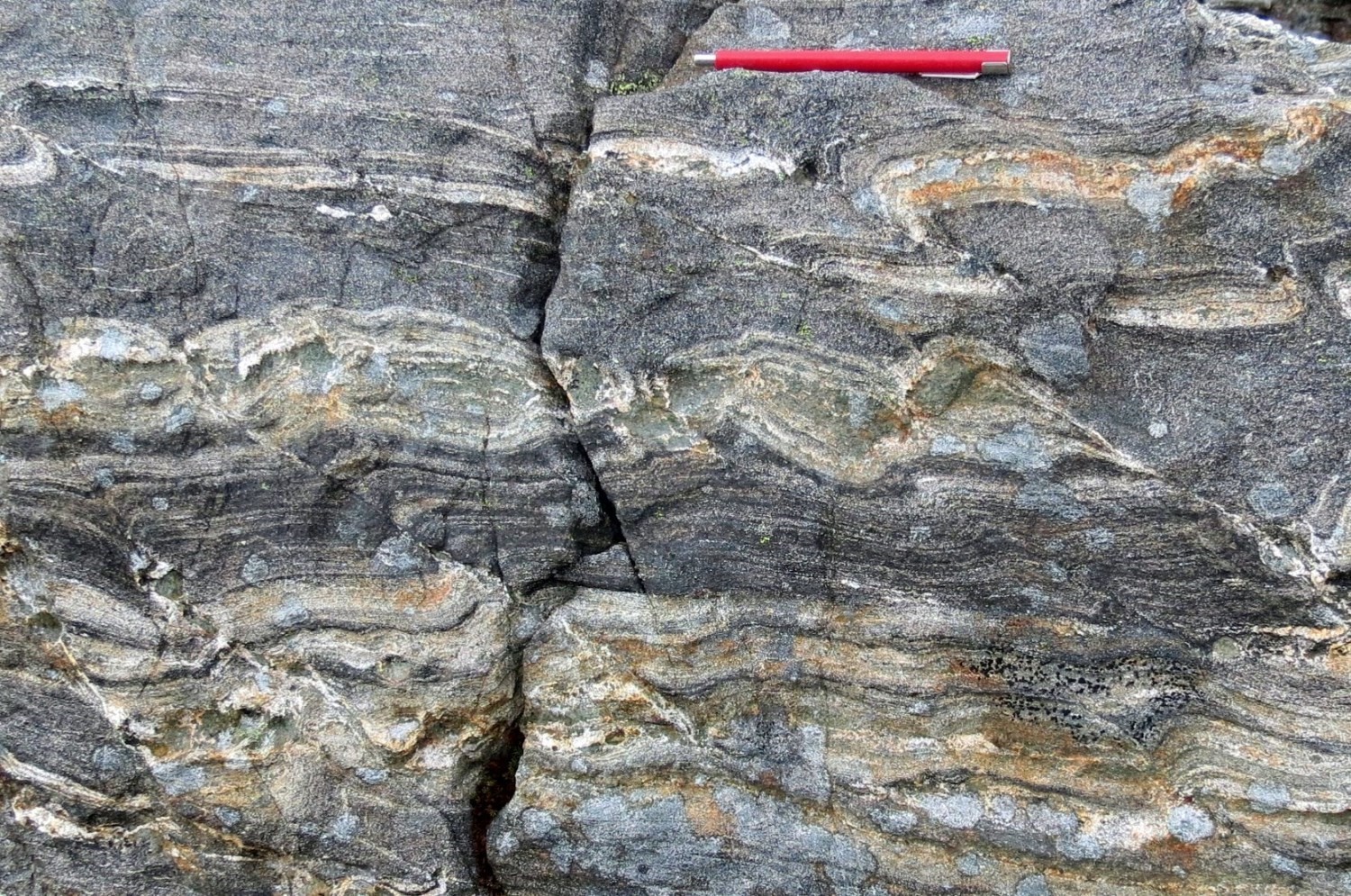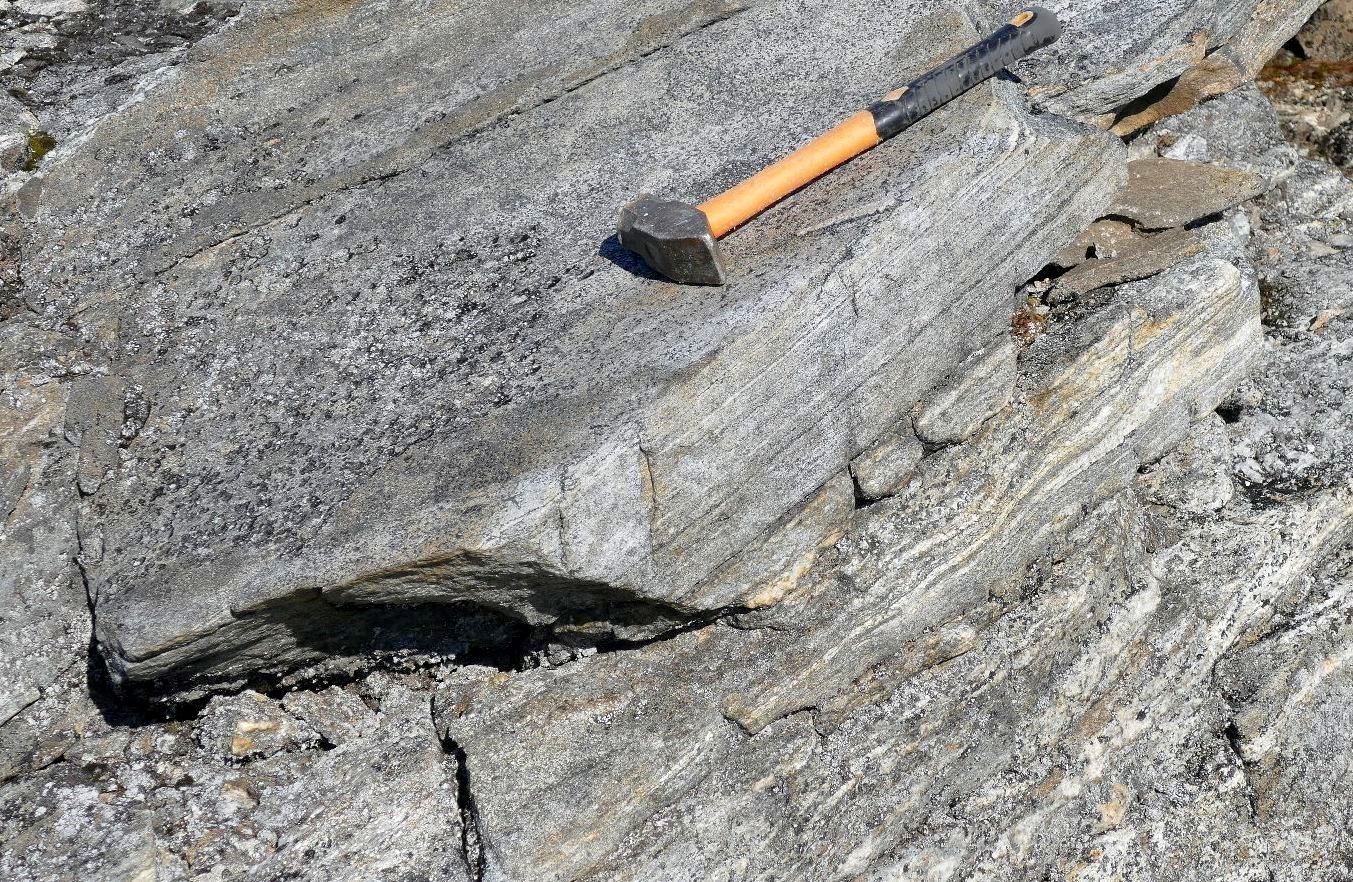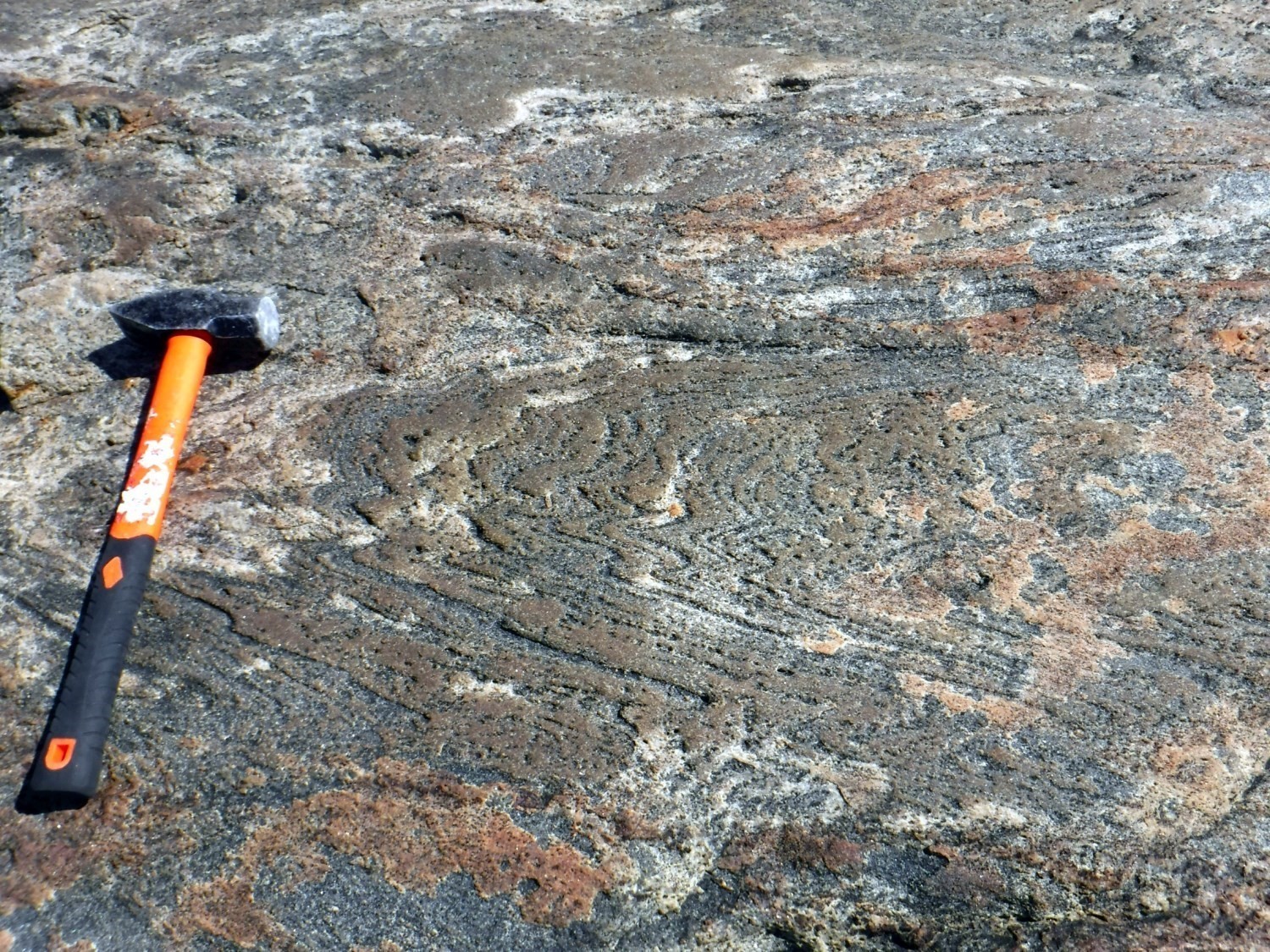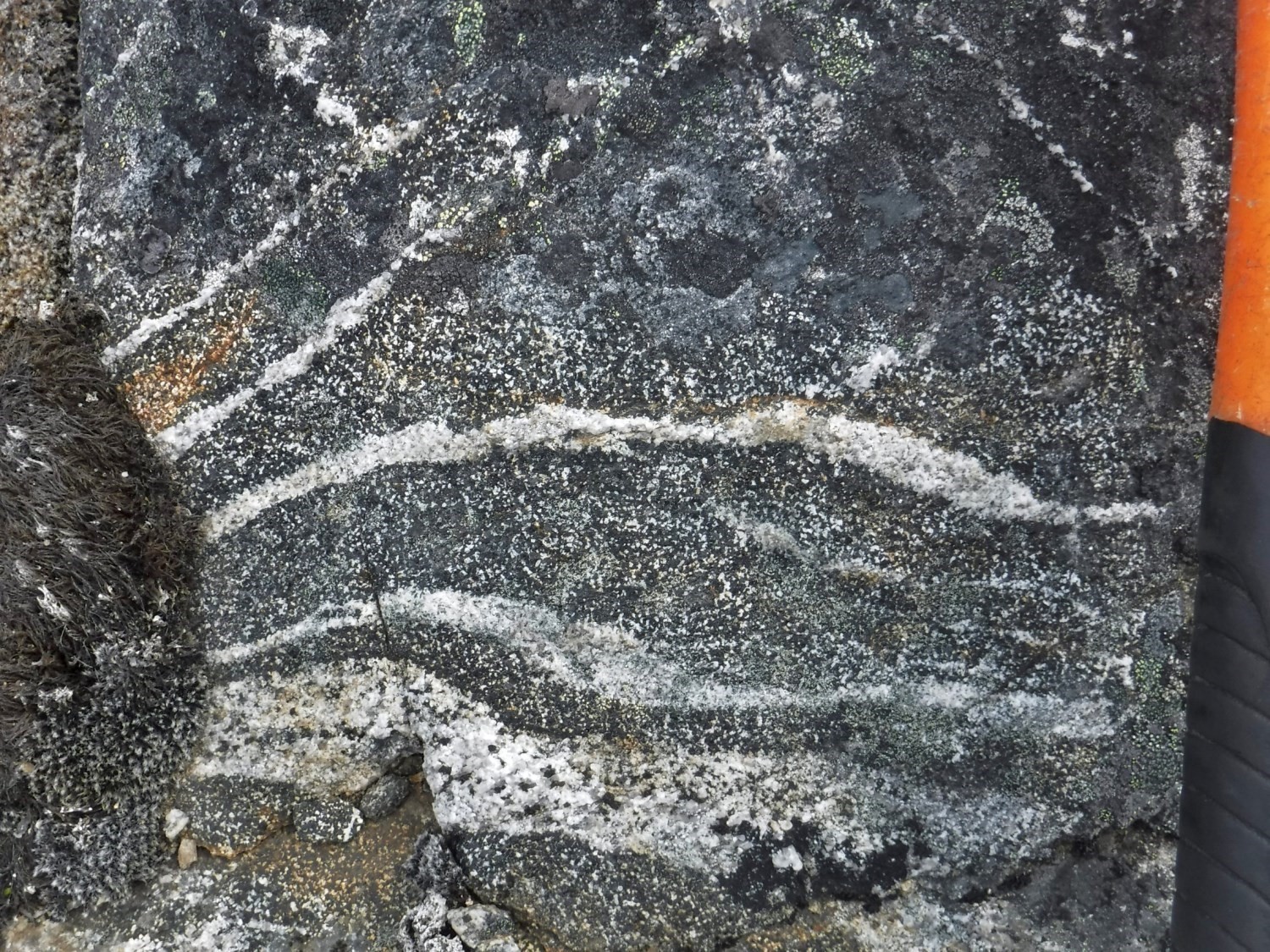
Last modified: 31 October 2023
Translation of original French
| Author(s): | Van Kranendonk et al., 1994 |
| Age: | Archean |
| Stratotype: | None |
| Type area: | Point Le Droit area (NTS sheet 24P) |
| Geological province: | Nain Province |
| Geological subdivision: | Burwell Lithotectonic Domain |
| Lithology: | Gneiss, paragneiss and amphibolite |
| Type: | Lithodemic |
| Rank: | Complex |
| Status: | Formal |
| Use: | Active |
None
Background
Van Kranendonk et al. (1994a) introduced the term “Noodleook Complex” to group a package of predominantly gneissic lithologies in the centre of the Torngat Mountains, bordering the Nain and Churchill provinces. The Noodleook Complex appears on geological maps of the Geological Survey of Canada following work covering the Torngats (Van Kranendonk, 1993, 1994a, 1994b; Van Kranendonk et al., 1994a, 1994b, 1995; Van Kranendonk and Wardle, 1994, 1995). The complex included the Hutton and Killinek suites, as well as Archean gneiss (Van Kranendonk and Wardle, 1996). Verpaelst et al. (2000) designated this unit as the “Iberville Complex” in the Circle Mountain area (NTS sheets 14L12 and 14L13). Mathieu et al. (2018) excluded from the Noodleook Complex Paleoproterozoic rocks of the Killinek Suite and mafic intrusions of the Hutton Suite to preserve only gneissic lithologies. The Noodleook Complex outcrops in mountainous areas in the Point Le Droit area (sheet 24P, Mathieu et al., 2018) and is not easily accessible. As a result, few outcrops were visited in this area.
The name of this unit comes from the Noodleook Fjord (sheet 24P16) in Labrador.
Description
The Noodleook Complex consists mostly of felsic gneiss of various compositions. It also includes intermediate to mafic layers and units. All the lithologies in this complex are fine grained and characterized by granoblastic, foliated and banded textures. Some areas have been affected by partial melting. Van Kranendonk et al. (1994a) consider this unit to be an Archean package metamorphosed to the granulite facies and then retrograded to the amphibolite facies in the Paleoproterozoic. Mathieu et al. (2018) corroborate these observations and note the presence of paragenesis compatible with the amphibolite facies, as well as preserved layers containing hypersthene (granulite facies).
The Noodleook Complex is subdivided into four informal units: 1) an amphibolite unit (Anoo1); 2) a tonalite, quartz diorite and granodiorite gneiss unit (Anoo2); 3) a paragneiss unit (Anoo3); and 4) a banded diorite and gabbro unit, amphibolitized with numerous white tonalite intrusions (Anoo4). These units generally form interstratifications across the outcrop.
Noodleook Complex 1 (Anoo1): Amphibolite
The unit was described by Van Kranendonk et al. (1994a). It is composed of fine-grained amphibolite, banded and dark green in both alteration patina and fresh exposure. The magnetic susceptibility of the rock is very low. Banding is associated with alternating centimetric layers that are more or less rich in green hornblende (50-90%). Some bands contain epidote or quartz. In thin section, minerals are even grained. Hornblende marks the foliation and shows grain edge migration, similar to plagioclase. Accessory phases are sphene, opaque minerals and apatite. Amphibolite is often affected by conformable intrusions of pink hololeucocratic syenogranite, medium to coarse grained and foliated.
Noodleook Complex 2 (Anoo2): Tonalite, Quartz Diorite and Granodiorite Gneiss
The unit outcrops near the southern and eastern contact of the Killinek Suite. It occurs as decametric to hectometric continuous bands. It is composed of light grey gneiss of mainly tonalitic composition, but which also contains granodioritic and granitic bands and layers, and minor proportions of intermediate to mafic bands. Banding is sharp and regular. Tonalitic layers are not magnetic; however, the magnetic susceptibility of granitic layers is high. Centimetric banding is associated with alternating laminae of 1-20% mafic minerals. Some millimetric to centimetric bands are hololeucocratic, medium grained, commonly discontinuous and have igneous texture. These bands are interpreted as mobilisate. Gneiss also contains millimetric and centimetric amphibolite bands. In addition, the unit is commonly intruded by transposed layers of coarse-grained leuocratic granite, whitish and deformed.
The dominant ferromagnesian phases are brown biotite and green hornblende. Hornblende is most abundant in the most mafic bands. Biotite is rich in zircon inclusions. The other phases are muscovite and, in places, clinopyroxene. Opaque minerals, sphene and apatite are observed as accessory phases. The quartzofeldspathic matrix is fine to medium grained and granoblastic. In the most deformed zones, grain edge migration patterns are recognized and plagioclase twins arecurved. Quartz has undulatory extinction. Granodioritic to granitic bands contain orthose and myrmekites.
Noodleook Complex 2a (Anoo2a): Hornblende-Biotite Dioritic Gneiss
This subunit is composed of non-magnetic mesocratic dioritic gneiss. The foliated rock is homogeneous and has a dark grey patina and fresh surface. It differs from the surrounding tonalitic gneiss beds due to the lack of banding, quartz poverty (<5%) and high homogeneity. In thin section, plagioclase is even grained, and hornblende and brown biotite are in equal proportions. Opaque minerals and apatite are observed as accessory phases.
Noodleook Complex 2b (Anoo2b): Tonalitic, Granodioritic and Dioritc Granulitic Gneiss
This subunit consists of the same lithologies as the main Anoo2 unit, but is distinguished by the presence of orthopyroxene. It includes granulitic gneiss varying in composition between tonalitic, granodioritic and dioritic. Subunit Anoo2b outcrops on the edge of Killinek Suite hypersthene intrusions, close to the contact between the latter and Tasiuyak Complex metatexites. It is also mapped as hectometric to kilometric klippes in the far north portion of the Torngat Mountains. Rocks in this subunit bear the brown sugar and olive colours characteristic of orthopyroxene-rich lithologies. The ferromagnesian phases are orthopyroxene, variably altered to iddingsite, red biotite, hornblende and, more scarcely, garnet. Accesory phases are opaque minerals, apatite and zircon. Plagioclase is sericitized.
Noodleook Complex 3 (Anoo3): Paragneiss
Bands and klippes of metasedimentary rocks outcrop as interstratifications in gneiss. These rusty, small (metric) layers are rarely mapped to the work scale. They are composed of paragneiss and metatexite of sedimentary origin. Lesser amounts (<10%) of biotite, garnet, muscovite, sulphides and graphite are present.
Noodleook Complex 4 (Anoo4): Banded Diorite and Gabbro, Amphibolitized with Numerous White Tonalite Intrusions
This unit consists of intermediate to mafic lithologies, amphibolitized and medium-grained. Green foliated rocks show banding of metric composition emphasized by many transposed intrusions (10-50%) of leucocratic tonalite. The partially recrystallized quartzofeldspathic matrix consists of medium grains with irregular edges, but also fine-grained granoblastic zones. It consists of 35-70% sericitized plagioclase and 5-15% quartz with undalory exticntion. Ferromagnesian phases account for up to 60% of the mode. The majority of them are green hornblende in granoblastic clusters or corroded poikiloblastic crystals containing numerous fine and rounded quartz inclusions. Clinopyroxene, orthopyroxene, brown biotite and garnet are also observed. Accessory minerals are apatite, epidote, scapolite, sphene, zircon and opaque minerals. Magnetic susceptibility is variable.
Thickness and distribution
The Noodleook Complex forms bands from a few kilometres to a few tens of kilometres long with decimetric to hectometric apparent thicknesses. These bands are located primarily between the main unit of the Tasiuyak Complex and intrusions of the Killinek Suite in the Point Le Droit area (sheet 24P). Klippes and enclaves are also reported in the northern portion of the Torngat Mountains in the Grenfeld Sound area (sheet 25A).
Dating
In Quebec, three Archean ages were obtained from tonalitic orthogneiss samples (Anoo2): 2797.6 ±5.8 Ma and 2823 Ma ±51 Ma (David, 2020), as well as 2757 ±12 Ma (Connelly, 2001).
In Labrador, Scott (1995) and Connelly (2001) made several datings in rocks of the Torngat Mountains. Ages between 2802 Ma and 2751 Ma have been obtained in samples of tonalite or tonalitic orthogneiss. A mafic orthogneiss (Anoo4) was dated at 2784 ±6 Ma. Some Paleoproterozoic crystallization ages suggest that some gneiss dated in Labrador may have a different origin. These Paleoproterozoic ages could also be associated with a first episode of partial melting.
| Unit |
Sample | Isotopic System | Mineral | Crystallization Age (Ma) | (+) | (-) | Metamorphic Age (Ma) | (+) | (-) | Reference(s) |
| Anoo2 | 2017-IL-3189A | U-Pb | Zircon | 2797.6 | 5.8 | 5.8 |
1888.3 1799 |
6.7 13 |
6.7 13 |
David, 2020 |
| 2017-IL-3187A | U-Pb | Zircon | 2823 | 51 | 51 | 1889.4 | 7.2 | 7.2 | ||
| D112 | U-Pb | Zircon | 2802 | 2 | 2 | – | – | – | Scott, 1995 | |
| Titanite | – | – | – | 1745 | 4 | 4 | ||||
| 7A | U-Pb | Zircon | 2757 | 12 | 12 | 1811 | 8 | 8 | Connelly,2001 | |
| Monazite | – | – | – | 1815 | 1 | 1 | ||||
| 1 | U-Pb | Zircon | 2771 | 2 | 2 | – | – | – | ||
| 6a | U-Pb | Zircon | 2751 | 9 | 7 | – | – | – | ||
| 4a | U-Pb | Zircon | 2784 | 6 | 6 | 2761 | 6 | 6 | ||
| Anoo4 | 4b | U-Pb | Zircon | 2784 | 7 | 7 | 2726 | 7 | 7 |
Stratigraphic Relationship(s)
Noodleook Complex gneiss is cut by intrusions of the Killinek Suite. Contacts between the two units are transposed. Klippes of metasedimentary rocks from the Tasiuyak Complex are also interbedded in the Noodleook Complex gneiss. Diabase dykes of the Falcoz and Avayalik swarms intrude into rocks of the complex and show straight and sharp contact.
Paleontology
Does not apply.
Références
Publications Available Through Sigéom Examine
DAVID, J., 2020. Datations U-Pb dans les provinces du Supérieur et de Churchill effectuées au GEOTOP en 2018-2019. MERN, GEOTOP; MB 2020-01, 30 pages.
MATHIEU, G., LAFRANCE, I., VANIER, M.-A., 2018. Géologie de la région de pointe Le Droit, Province de Nain et sud-est de la Province de Churchill, Nunavik, Québec, Canada. MERN; BG 2018-07, 4 plans.
VERPAELST, P., BRISEBOIS, D., PERREAULT, S., SHARMA, K. N. M., DAVID, J., 2000. Géologie de la région de la rivière Koroc et d’une partie de la région de Hébron, 24I et 14L. MRN; RG 99-08, 62 pages, 10 plans.
Other Publications
CONNELLY, J. N., 2001. Constraining the timing of metamorphism: U-Pb and Sm-Nd ages from a transect across the Northern Torngat Orogen, Labrador, Canada. The Journal of Geology, 109, pages 57-77. https://www.journals.uchicago.edu/doi/full/10.1086/317965
SCOTT, D.J. 1995. U-Pb geochronology of the Nain craton on the eastern margin of the Torngat Orogen, Labrador. Canadian Journal of Earth Sciences; volume 32, pages 1859-1869. https://doi.org/10.1139/e95-143
VAN KRANENDONK, M.J. 1993. Geology, Mont Jacques-Rousseau, Québec-Newfoundland (Labrador). Geological Survey of Canada; Open File 2738, 1 map. https://doi.org/10.4095/183959
VAN KRANENDONK, M.J. 1994a. Geology, Tower Mountain, Newfoundland (Labrador)-Québec. Geological Survey of Canada; Open File 2828, 1 map. https://doi.org/10.4095/194136
VAN KRANENDONK, M.J. 1994b. Geology, Rivière Lepers, Québec-Northwest Territories. Geological Survey of Canada; Open File 2829, 1 map. https://doi.org/10.4095/194055
VAN KRANENDONK, M.J., WARDLE, R.J. 1994. Geology, Ryans Bay, Newfoundland (Labrador)-Québec; Geological Survey of Canada; Open File 2926, 1 map. https://doi.org/10.4095/194834
VAN KRANENDONK, M.J., WARDLE, R.J. 1995. Geology, Lac Baret, Québec-Newfoundland (Labrador). Geological Survey of Canada; Open File 2985, 1 map. https://doi.org/10.4095/203612
VAN KRANENDONK, M.J., WARDLE, R.J. 1996. Burwell domain of the Palaeoproterozoic Torngat Orogen, northeastern Canada: Tilted cross-section of a magmatic arc caught between a rock and a hard place. In: Precambrian Crustal Evolution in the North Atlantic Region (Brewers, T.S., editor). Geological Society, London; Special Publications 112, pages 91-115.
VAN KRANENDONK, M.J., WARDLE, R.J., MENGEL, F.C., CAMPBELL, L.M., REID, L. 1994a. New results and summary of the Archean and Paleoproterozoic geology of the Burwell domain, northern Torngat Orogen, Labrador, Quebec, and Northwest Territories. In: Current Research 1994-C. Geological Survey of Canada; Current Research 1994-C, pages 321-332. https://doi.org/10.4095/193840
VAN KRANENDONK, M.J., WARDLE, R.J., MENGEL, F.C., CHURCHILL, R., CAMPBELL, L.M., SCHWARTZ, S. 1994b. Geology, Lac de Lorière, Newfoundland (Labrador)-Québec. Geological Survey of Canada; Open file 2925, 1 map. https://doi.org/10.4095/194833
VAN KRANENDONK, M.J., WARDLE, R.J., MENGEL, F.C., CAMPBELL, L.M., GODIN, L., SCOTT, D.J., CHURCHILL, R., SCHWARZ, S., REID, L., RYAN, B., BRIDGWATER, D., HAUMANN, A., PATEY, R. 1995. Geology of the Archean Nain Province and Paleoproterozoic Torngat Orogen, Newfoundland (Labrador) – Quebec – Northwest Territories. Geological Survey of Canada; Open File 2927, 4 maps. https://doi.org/10.4095/203609
Suggested Citation
Ministère des Ressources naturelles et des Forêts (MRNF). Noodleook Complex. Quebec Structural Lexiconc. https://gq.mines.gouv.qc.ca/lexique-stratigraphique/province-de-nain/complexe-de-noodleook_en/ [accessed on Day Month Year].
Contributors
|
First publication |
Guillaume Mathieu, Eng. Geo., M.Sc. guillaume.mathieu@mrnf.gouv.qc.ca (redaction) Mehdi A. Guemache, P. Geo., Ph.D. (coordination); Claude Dion, Eng. Geo., M.Sc. (critical review); Simon Auclair, P. Geo., M.Sc. (editing); Céline Dupuis, P. Geo., Ph.D. (English version); Ricardo Escobar Moran (HTML editing). |








